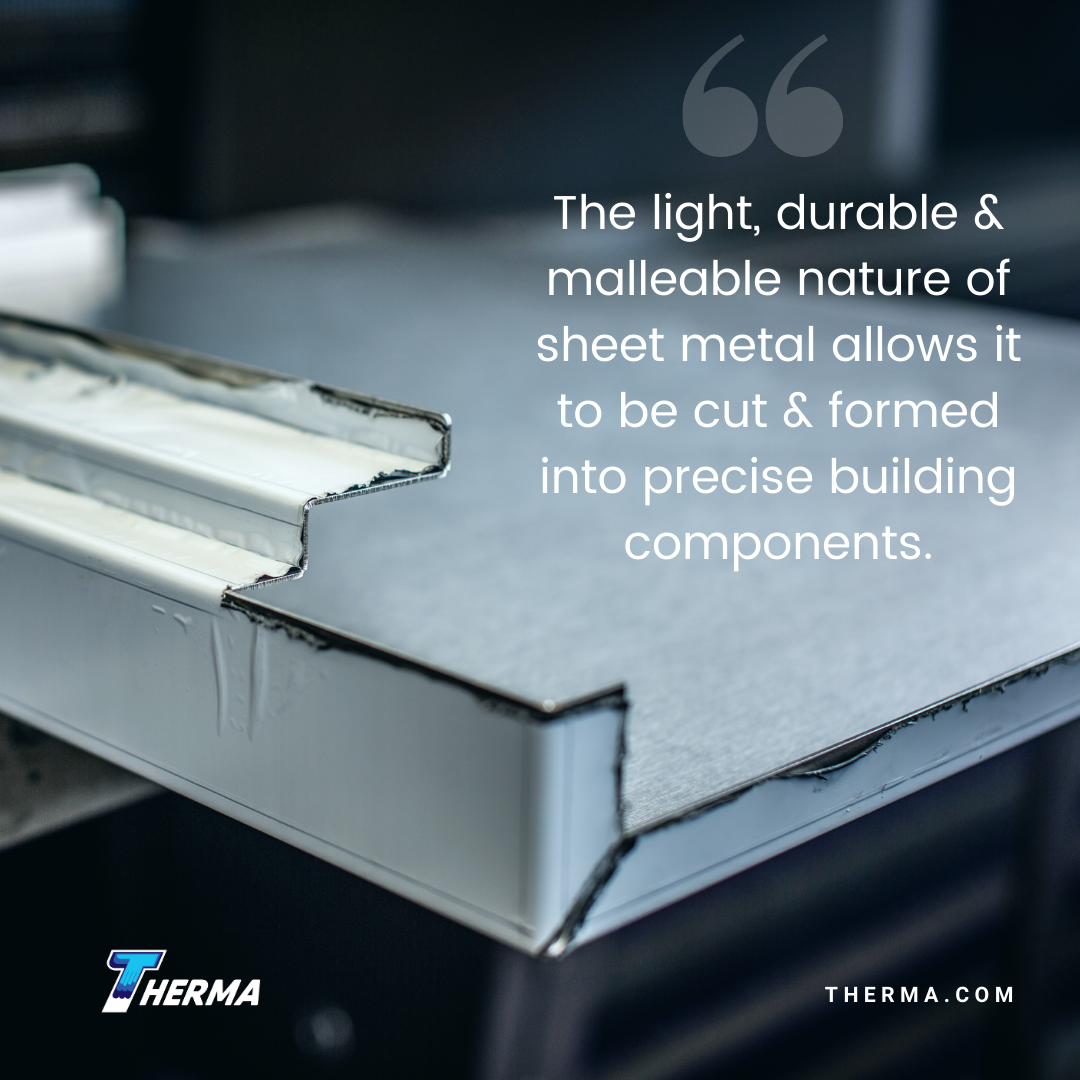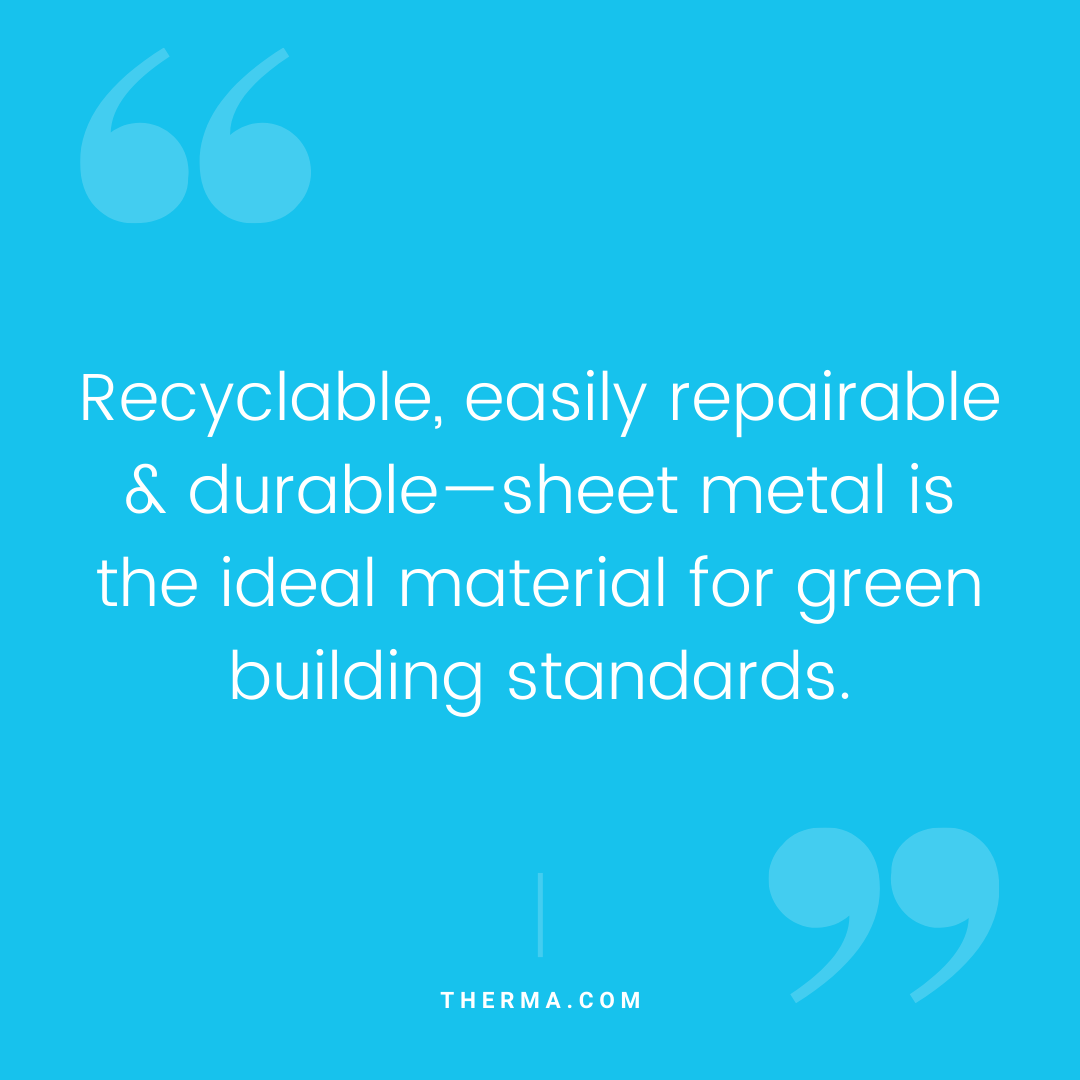by Ali Kriscenski
Sheet metal is essential to building construction as a material in structural elements, MEP/FP systems and as an interior or exterior finish material. Having an in-depth understanding of the different types of sheet metal and the materials used to create them enables you to align the selection process with your project requirements and goals.
Sheet Metal Applications
Sheet metals can be used for a multitude of applications on building exteriors as functional and decorative elements. Custom-fabricated louvers and dormers can add architectural interest while incorporating elements that support passive energy strategies. The weather-resistant qualities and malleability make sheet metals ideal for stormwater management components such as gutters and downspouts. Those same attributes make this metal a versatile choice for building facades and roofing.
Building systems and interiors also rely on a wide variety of sheet metal applications. Plumbing and HVAC fixtures and assemblies made from sheet metal can be prefabricated. When combined with BIM modeling, the process of prefabrication can eliminate on-site system conflicts and result in cost savings. Sheet metals can be used for primary structural elements, lighting, wall finishes, millwork assemblies and to create functional staircases.
Benefits of Sheet Metal in Construction
As a construction material, sheet metal provides many benefits. It is well known for its strength and can be fabricated to meet structural elements’ specifications. It’s also very resistant to sun, moisture and corrosion. It’s light, durable and malleable nature allow it to be cut and formed into precise building components.
From a lifecycle perspective, sheet metals possess a wide range of desirable qualities. They are recyclable, easily repairable and durable, making them ideal for green building standards. In fact, 93% of structural steel in the U.S. consists of recycled material. Its high quality, versatility and durability makes sheet metal cost-effective for both large and small applications.
Types of Sheet Metal
The variety of sheet metal forming processes allows for products to be made from a wide range of metals. Some of the most common materials include the following:
Stainless Steel
Stainless steel is corrosion-resistant and can be easily fabricated. It is often used as a structural component to meet engineering requirements. Stainless steel is less likely to warp, deform, or scratch from heat or force, making it an excellent choice in sanitary or sterile environments. It can also be used in roofing materials, cladding, handrails and water management systems.
Aluminum
While lower in strength, aluminum is lightweight and highly resistant to water and corrosion. It is a low-maintenance material that can be anodized or lacquered to meet design specifications. As a versatile material, it can be used for external facades, roofing, walls, windows, doors and also as a finish for architectural elements such as shelving.
Copper & Brass
Copper is a flexible, lightweight material that is corrosion-resistant and easy to shape. Its versatility makes it useful for roofing, plumbing, water and gas distribution. Its low maintenance and durable qualities make it a long-lasting material for MEP systems and as a decorative or exterior element. An alloy of copper, brass has more strength, corrosion resistance and formability.
Standard Sheet Metal Sizes
The metal’s thickness determines its category, whether it’s a foil, sheet or plate. Standard measurements are in gauges, but often times mills or millimeters that are used in engineering and manufacturing. Metal foil is common with aluminum, and its thickness is up to 0.2 mm. Sheet metal thickness ranges from 0.5 mm to 6 mm, and above that level, it is categorized as plating.
Sheet Metal for Building Fabrication
Sheet metal is used in various building systems, including roofing, HVAC, plumbing and more. When it comes to selecting the right type, factors such as corrosion-resistance, metal strength and density are just a few things to consider. Contact us today to help you navigate the best selection for your project and to custom fabricate your building needs in our sheet metal shop.
Ali Kriscenski was trained in high-performance building design at Boston Architectural College. She has worked with leading architecture and construction firms in NYC and New England, and served on the executive team at Forest Stewardship Council International. She was Managing Editor at Inhabitat and has worked pro bono for the Green Building Institute, ISEAL Alliance and Habitat for Humanity.









